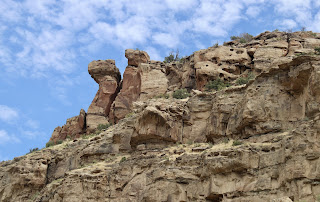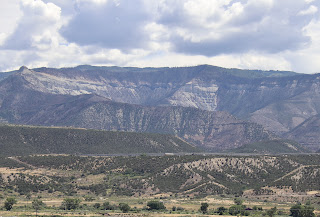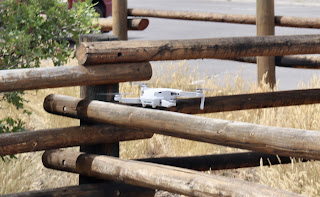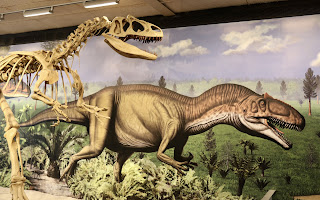We headed out late morning, eager to get to the monument before the heat of the day. The drive to the site took us through horse and cattle country. As we got close, we could see the cliffs and rock formations that held a treasure trove of Jurassic-period fossils. In 1909, paleontologist Earl Douglass, from Pittsburgh’s Carnegie Museum, found eight vertebrae of a dinosaur called Apatisayrus in the arid badlands of eastern Utah. He had stumbled upon one of the world’s greatest collections of dinosaur fossils. As we drove through the ever changing landscape, placards described the type of rock formations we were seeing, the timeframe it represented and the animals that would have lived there. How amazing to know that millions of year ago, all this area was a sea. How do they know? The fossils of sharks and other aquatic animals have been found in the rocks.
There was so much we saw and learned it is hard to known what to tell you. I thought we would be walking among the rocks and seeing where the fossils had been found. But no. Because of the likelihood of damage to delicate fossils by visitors, the only way we could see them was to visit what they call the Quarry Exhibit Hall. It is important to note that the hall was built around the rock excavation area. Once the scientists finished their study and cataloging all the specimens, the hall was constructed.
But first, a bit of background. Over the years, paleontologist have found fossilized bones of various species. They more or less make educated guesses about what the animals actually looked like. Think about a gig saw puzzle. Without all the pieces or a picture of the completed puzzle, it would be pretty impossible to complete it. That is pretty much what it is like trying to determine what an animal looks like without all the bones. Very often, animals die near water. As water washes over their bones or animals scavenge the bones, they are articulated (pulled apart) and washed downstream. The result is a mass of bones jumbled together in a mess. Sometimes, they find sections such as vertebrae or ribs that are still intact. Rarely do they find a skull with all bones and teeth in tact. Thus, what they think they know may change 20, 30 or more years later when new findings tell them more about the animal than known before. At the Quarry Exhibit Hall, a large wall of fossils in situ are on display for the public observation. This approach was not only to protect the fossils but also to allow the public to see them up close. Here are some pictures so you can see them.

This fossilized skeleton of young Camarasaurus (kuh-MARE-uh-SAWR-us) is the most complete long-necked dinosaur ever found. Long-necked dinosaurs are known as sauropods. With this discovery in 1919, scientists were able to reconstruct a sauropod skeleton based on a single specimen for the first time. Before, ideas about sauropods were based on
incomplete skeletons
Allosaurus (AL-uh-SAWR-us) was the dominant predator of the Jurassic Period. This is skull of one of the most complete meat-eating dinosaur skeletons ever found in Late Jurassic rocks.
This fellow is another example of skulls found. This is a cast of the actual skull which is 149 million years old. Hard to even think about something that old.
This dinosaur was the most common predatory animal in the Morrison ecosystem. Allosaurus was well adapted to its predatory role. Sharp serrated teeth lined its powerful jaws. Large curved claws and powerful arm and leg muscles allowed it to kill and eat smaller dinosaurs. Allosaurus probably also ate carcasses of animals that were already dead. This is a cast skeleton of an Allosaurus from the Cleveland-Lloyd Quarry in east-central Utah. It is about the same size as the individual from this quarry whose large skull is on exhibit here.
The picture behind the skeleton is what they think the Allosaurus looked like.
After visiting the Quarry, we decided to drive a short distance to see some petroglyphs. Yea, I will finally get to see some. Here are some pictures.
Time and the elements have taken a toll on these petroglyphs but they were still amazing to see. No one really knows what they represent or if they tell a story. But they tell us about the native people who lived in this area a long time ago, long before Europeans came to this land.
We headed back to Vernal after our walk with the dinosaurs. I have laundry to do and preparations to make for our drive to Colorado tomorrow.


















































